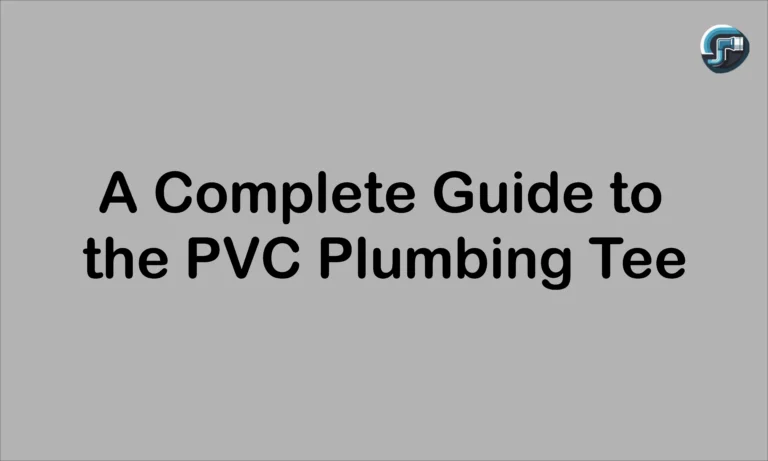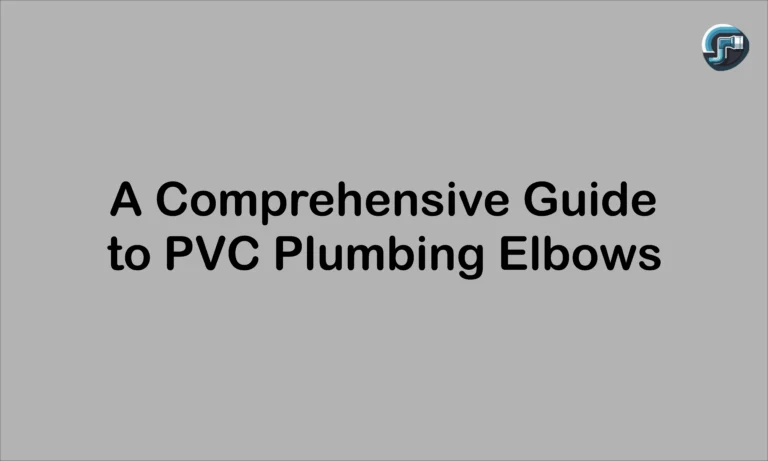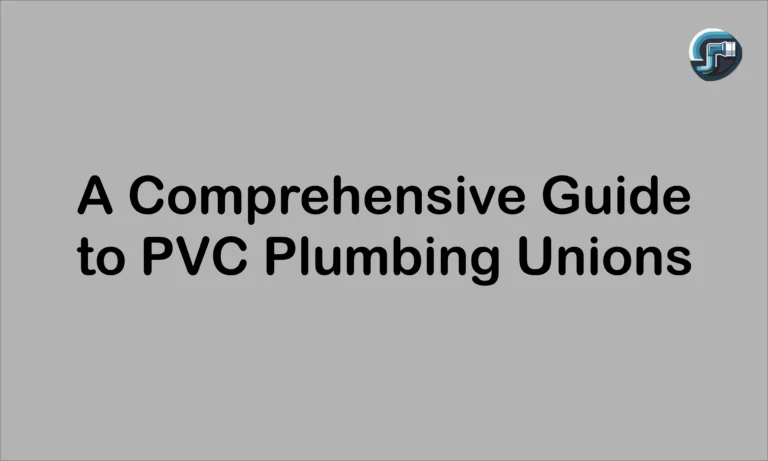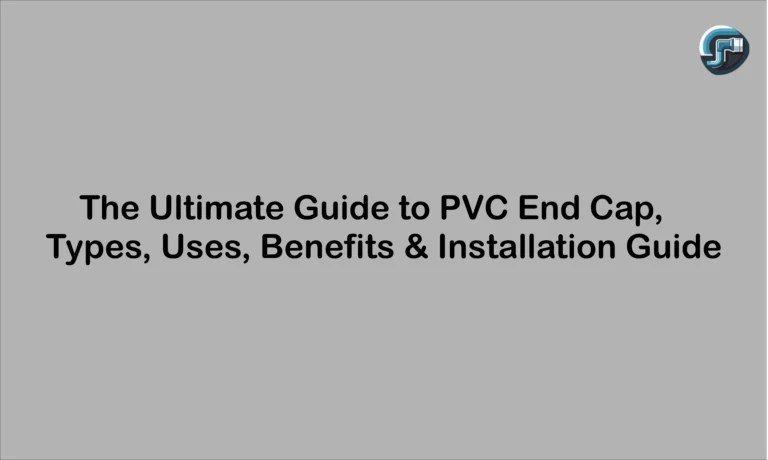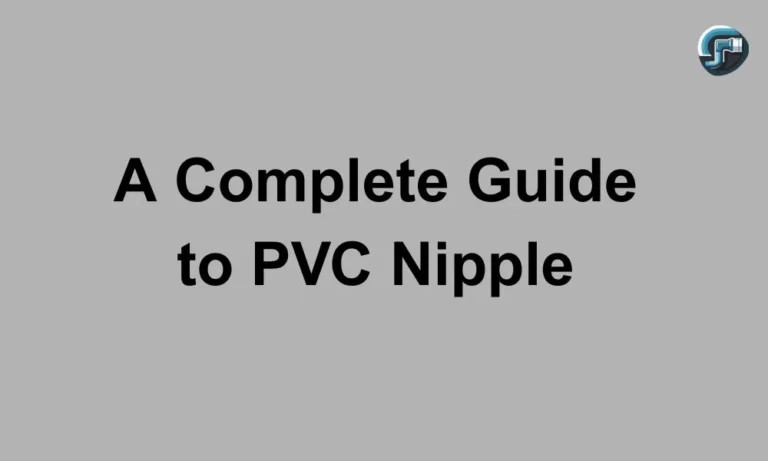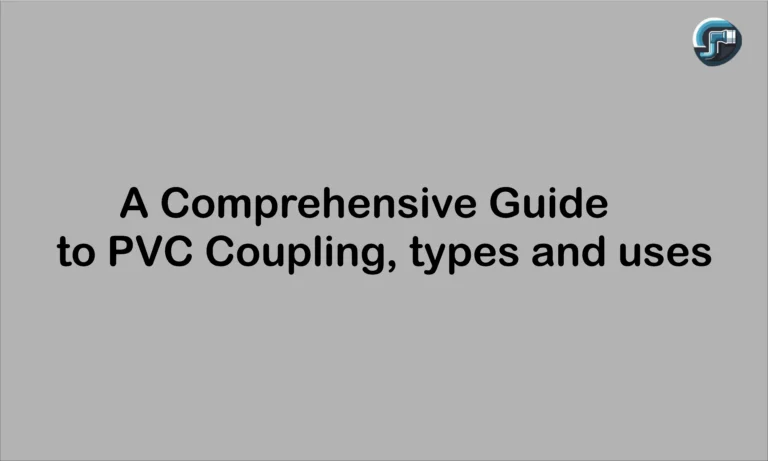PVC Valves – Durable Plastic Valves for Plumbing & Industrial Use
PVC valve forms an important element in plumbing and fluid handling systems and is designed to efficiently and reliably regulate, control, and direct fluid flow. They are constructed of polyvinyl chloride (PVC) – an extremely lightweight, strong, and corrosion-resistant material – which is indeed a cheaper alternative to metal valves. PVC valves find application in many areas, including residential, commercial, agricultural, and industrial. Regardless of application, PVC valves have proved excellent in water lines, irrigation, chemical processing, and wastewater systems. There are a variety of choices such as ball, gate, check, and butterfly valves that give a good choice for flow control.
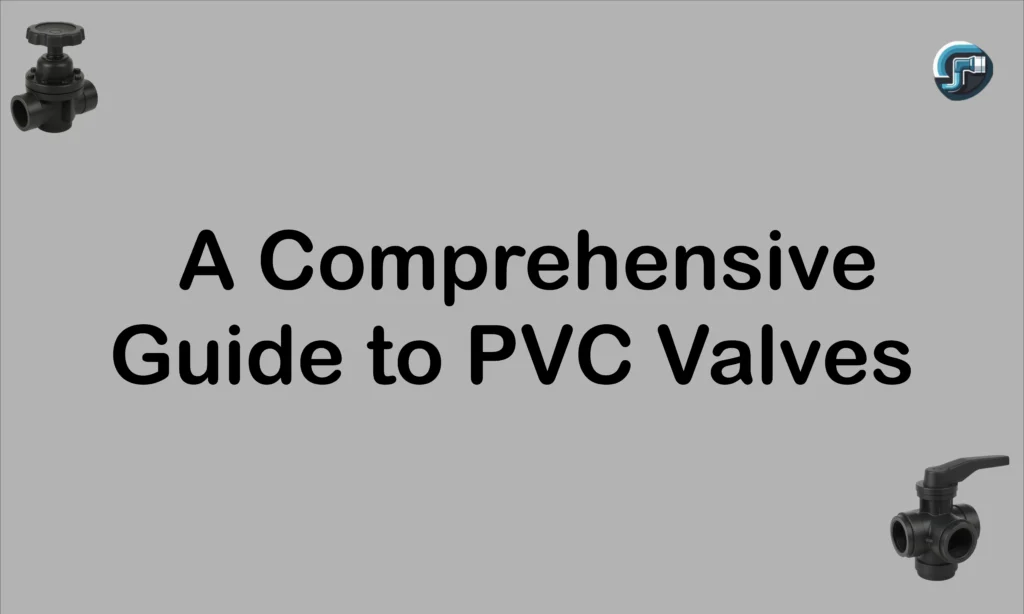
Types of PVC Valves
There are different types of PVC Valves, each of them has its own working. The types are mentioned below.
PVC Ball Valves
PVC Ball Valves are an integral part of almost every fluid control system available in the market. They are impressively simple and handy to operate. This type of valve works on the principle of a rotating ball with a bore to control the fluid flow through either liquids or gases. A very simple and immediate operation is done in a quarter-turn of the handle to align the bore with the pipe to flow positively or to place the bore perpendicularly to block it.
One of the greatest benefits of PVC ball valves is that they are very durable and resistant to corrosion and chemicals. This property makes these ball valves suitable for domestic plumbing applications to high-demand industrial environments. Compared to their metal counterparts, PVC ball valves cost less but perform the same service without such a burden on the budget.
Examples of the universality of PVC balls are plentiful. Irrigation systems, swimming pools, aquariums, and many others are actually dealing with water and very common chemicals that can already be found in plastics. Used also in a wide variety of chemical processing, these ball valves do not react with the products processed in them. They can also be found in water treatment plants, and it can be said that in every corner of food and beverage production, they have also found their way. Some common PVC Ball Valves sizes are 1 inch PVC ball valve and 2 inch PVC Ball Valve.

| Nominal Size (Inches) | Nominal Size (mm) | Socket End (mm) | Thread End (BSP/NPT) | Pressure Rating |
| 1/2″ | 15 mm | 20 mm | 1/2″ | 150 PSI |
| 3/4″ | 20 mm | 25 mm | 3/4″ | 150 PSI |
| 1″ | 25 mm | 32 mm | 1″ | 150 PSI |
| 1 1/4″ | 32 mm | 40 mm | 1 1/4″ | 150 PSI |
| 1 1/2″ | 40 mm | 50 mm | 1 1/2″ | 150 PSI |
| 2″ | 50 mm | 63 mm | 2″ | 150 PSI |
| 2 1/2″ | 65 mm | 75 mm | 2 1/2″ | 150 PSI |
| 3″ | 80 mm | 90 mm | 3″ | 150 PSI |
| 4″ | 100 mm | 110 mm | 4″ | 150 PSI |
Single Union Ball Valves
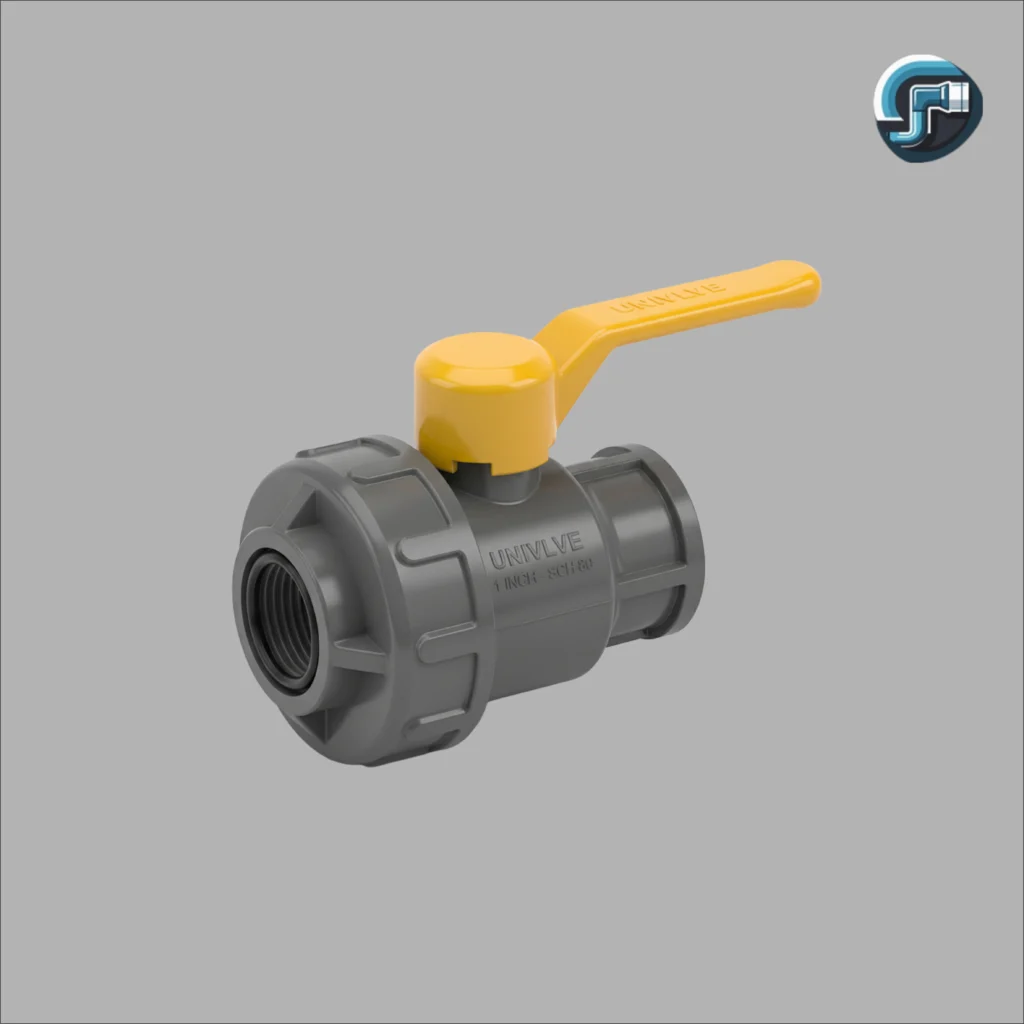
A single union ball valve is a good and cheap way to control the flow of fluids in homes, offices, and light industries. The valve is made of strong PVC (polyvinyl chloride) and has a single removable union end that makes it easy to install, clean, or replace without having to take apart the pipeline. The valve is controlled by a quarter-turn handle that turns an internal ball. This allows for full flow or completely shuts off the passage, depending on what you want.
One significant aspect of the PVC Single Union Ball Valve is its lightness and ability to withstand corrosion, thus making it useful for water supply, irrigation, and chemical-handling applications. PVC, unlike metal valves, cannot rust or corrode, thus its life is further assured in extreme environmental conditions. Small design and reasonable price make it really a very attractive option for the owner, the gardener, the pool operator, and small industries that need a dependable and yet inexpensive flow control solution.
| Nominal Size (Inches) | Nominal Size (mm) | Socket End (mm) | Thread End (BSP/NPT) | Pressure Rating |
| 1/2″ | 15 mm | 20 mm | 1/2″ | 150 PSI |
| 3/4″ | 20 mm | 25 mm | 3/4″ | 150 PSI |
| 1″ | 25 mm | 32 mm | 1″ | 150 PSI |
| 1 1/4″ | 32 mm | 40 mm | 1 1/4″ | 150 PSI |
| 1 1/2″ | 40 mm | 50 mm | 1 1/2″ | 150 PSI |
| 2″ | 50 mm | 63 mm | 2″ | 150 PSI |
| 2 1/2″ | 65 mm | 75 mm | 2 1/2″ | 150 PSI |
| 3″ | 80 mm | 90 mm | 3″ | 150 PSI |
| 4″ | 100 mm | 110 mm | 4″ | 150 PSI |
Double Union PVC Ball Valve
The Double Union Ball Valve is a strong PVC (polyvinyl chloride) flow control valve that has two union ends that can be removed for more flexibility and ease of use. You can’t take apart a single union valve from both ends of the pipe, but you can do it with a double union valve. This makes it simple and quick to install, repair, and change. There is a handle that spins a ball with a hole in it. This makes it easy to turn on and off.
The PVC Double Union Ball Valve is great because you can do a lot with it. You can take it out without cutting the pipe, which is great for systems that need a lot of cleaning, fixing, or maintenance. The PVC body is light, won’t rust or corrode, and won’t react with chemicals. You can use this for a lot of things, like plumbing in homes, watering gardens, swimming pools, aquariums, water treatment plants, and industrial systems that don’t need a lot of pressure.
The double union shape makes it strong and easy to clean. It also keeps the connection safe and leak-free for a long time. PVC things don’t rust, scale, or break down chemically, so they always work the same way. People who work in the field, contractors, and homeowners all like it because it’s easy to use and doesn’t cost much.
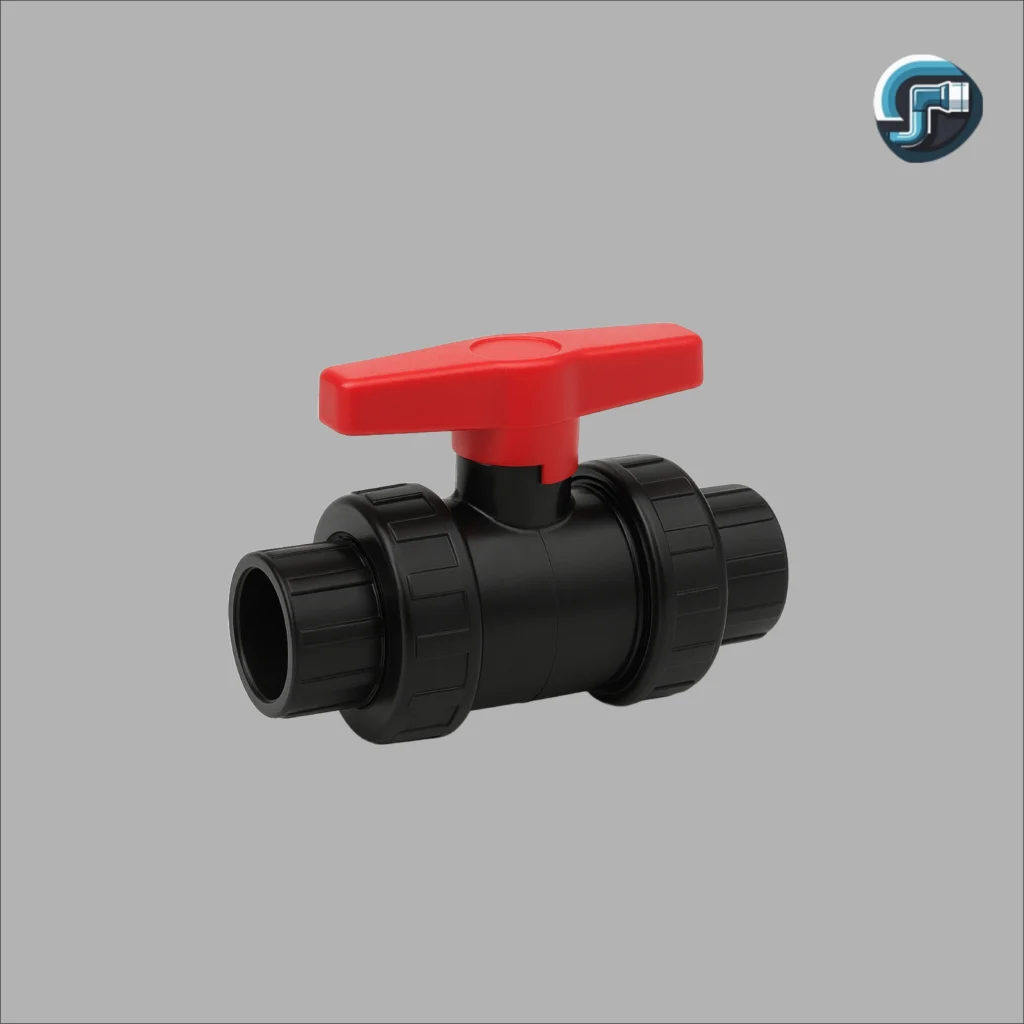
| Nominal Size (Inches) | Nominal Size (mm) | Socket End (mm) | Thread End (BSP/NPT) | Pressure Rating |
| 1/2″ | 15 mm | 20 mm | 1/2″ | 150 PSI |
| 3/4″ | 20 mm | 25 mm | 3/4″ | 150 PSI |
| 1″ | 25 mm | 32 mm | 1″ | 150 PSI |
| 1 1/4″ | 32 mm | 40 mm | 1 1/4″ | 150 PSI |
| 1 1/2″ | 40 mm | 50 mm | 1 1/2″ | 150 PSI |
| 2″ | 50 mm | 63 mm | 2″ | 150 PSI |
| 2 1/2″ | 65 mm | 75 mm | 2 1/2″ | 150 PSI |
| 3″ | 80 mm | 90 mm | 3″ | 150 PSI |
| 4″ | 100 mm | 110 mm | 4″ | 150 PSI |
PVC Gate Valve
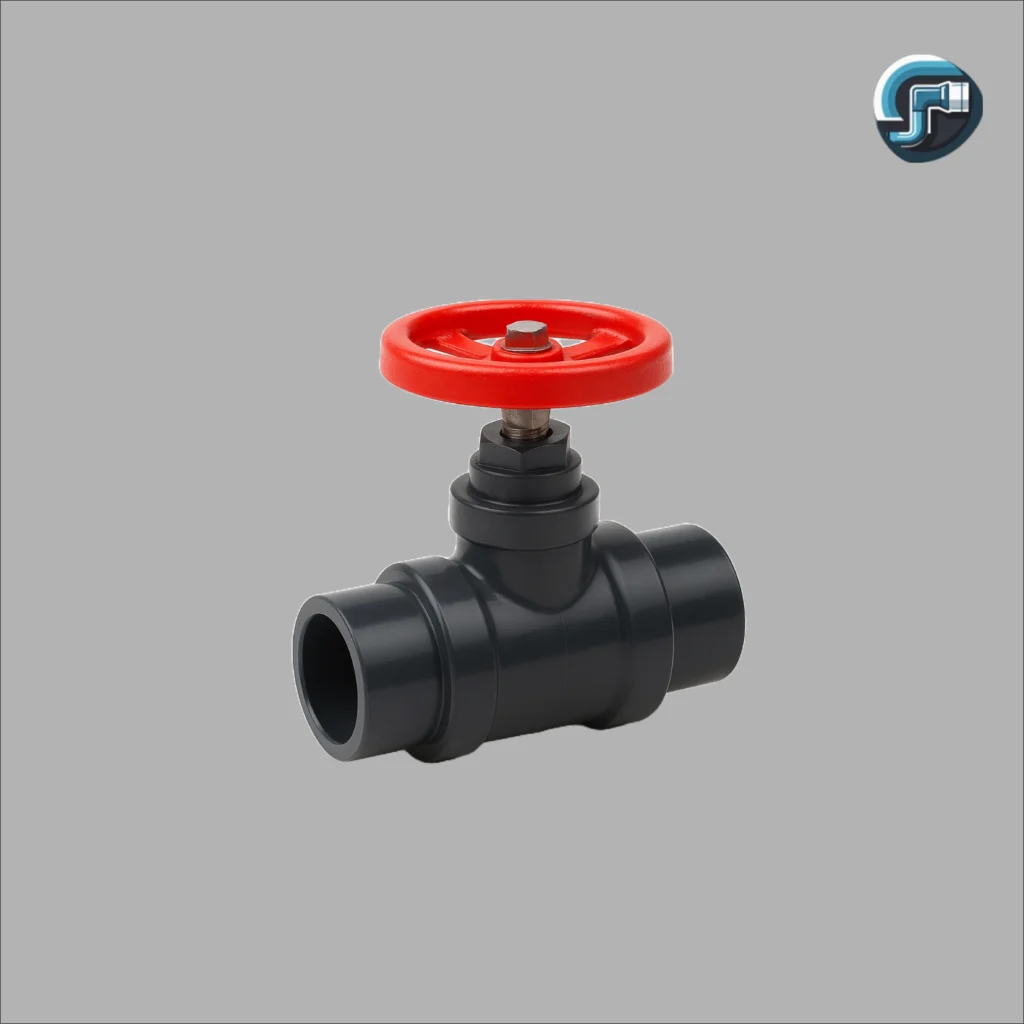
A PVC Gate Valve is the term used for a valve that can be opened to allow liquid to flow freely through it or can be shut completely against the gate inside the valve. It is made of polyvinyl chloride, an extremely durable plastic, and is therefore lightweight and cost-effective when compared to its metal counterparts. PVC gate valves are corrosion-resistant and serve as an economical alternative to conventional metal gate valves. Ball valves are, rather, employed in applications for instant shut-off while a gate valve allows an unobstructed, straight flow path with negligible pressure drop when fully open or closed.
The working principle of PVC gate valves is typical-the handwheel turns and the internal gate moves up or down to allow fluid passage. Ideal for systems that require complete isolation from the entrance and throttling as well, since the gate movement is transverse to the flow and at this position provides full-bore opening, it allows fluid transfer without turbulence when the gate is fully raised.
PVC gate valves find applications in water supply systems, irrigation lines, aquaculture, swimming pools, wastewater treatment, and a few chemical applications. These valves are ideal for chemical applications and their non-corrosive nature makes them used in places where metal valves deteriorate quickly. Moreover, their requirements in maintenance and affordability make them a realistic answer for residential and commercial applications as well.
Generally, however, PVC gate valves are better suited for low to medium-pressure applications and cannot be used in applications with high temperatures because PVC tends to soften at high temperatures.
To sum up, the PVC Gate Valve is a cost-effective solution for control of the flow of fluids; it is not only lightweight and durable, but also cost-effective. Furthermore, being completely unobstructed in the way it operates, does not encourage corrosion as compared to other valves and is also easy to use and therefore is reliable for most applications, plumbing, agriculture, and industrial, where good regulation of flow is important.
| Nominal Size (Inches) | Nominal Size (mm) | Socket End (mm) | Thread End (BSP/NPT) | Pressure Rating |
| 1/2″ | 15 mm | 20 mm | 1/2″ | 150 PSI |
| 3/4″ | 20 mm | 25 mm | 3/4″ | 150 PSI |
| 1″ | 25 mm | 32 mm | 1″ | 150 PSI |
| 1 1/4″ | 32 mm | 40 mm | 1 1/4″ | 150 PSI |
| 1 1/2″ | 40 mm | 50 mm | 1 1/2″ | 150 PSI |
| 2″ | 50 mm | 63 mm | 2″ | 150 PSI |
| 2 1/2″ | 65 mm | 75 mm | 2 1/2″ | 150 PSI |
| 3″ | 80 mm | 90 mm | 3″ | 150 PSI |
| 4″ | 100 mm | 110 mm | 4″ | 150 PSI |
| 5″ | 125 mm | 140 mm | 5″ | 150 PSI |
| 6″ | 150 mm | 160 mm | 6″ | 150 PSI |
PVC Check Valve
A PVC Check Valve is a one-way valve that permits a liquid to flow in one direction while restricting backflow to protect the pumps, pipelines, and other pieces of equipment from possible damage. These check valves are used in residential, agricultural, and industrial systems wherein the check valve is lightweight, strong, and does not corrode, thus made from PVC (Polyvinyl Chloride).
A PVC check valve does not work on a complicated principle: the valve opens on evaporation in the direction of the intended flow and closes on flow stoppage or flow reversal. It guarantees that water, chemicals, and other liquids do not flow back, which is of utmost importance in systems that pump. PVC check valves are also some of the easiest valves to work with, as they are low-cost compared to metal valves and require much less maintenance.
There are several types of PVC check valves, each suited to different applications:
- Swing Check Valve – Features a hinged disc that swings open with flow and closes to stop reverse flow; common in water supply and irrigation systems.
- Spring Check Valve – Uses a spring-loaded mechanism for quick and secure closure, preventing water hammer; ideal for vertical or horizontal installations.
- Ball Check Valve – Contains a free-moving ball that seals against a seat to block reverse flow; widely used in wastewater and slurry applications.
- Foot Valve – A check valve with a strainer, installed at the end of suction lines to prevent debris entry and maintain pump priming.
PVC check valves are commonly used in pumping systems, irrigation lines, aquariums, swimming pools, water treatment plants, and chemical handling applications. Their lightweight design, chemical resistance, and cost-effectiveness make them a trusted choice for ensuring smooth, one-directional flow in various piping systems.
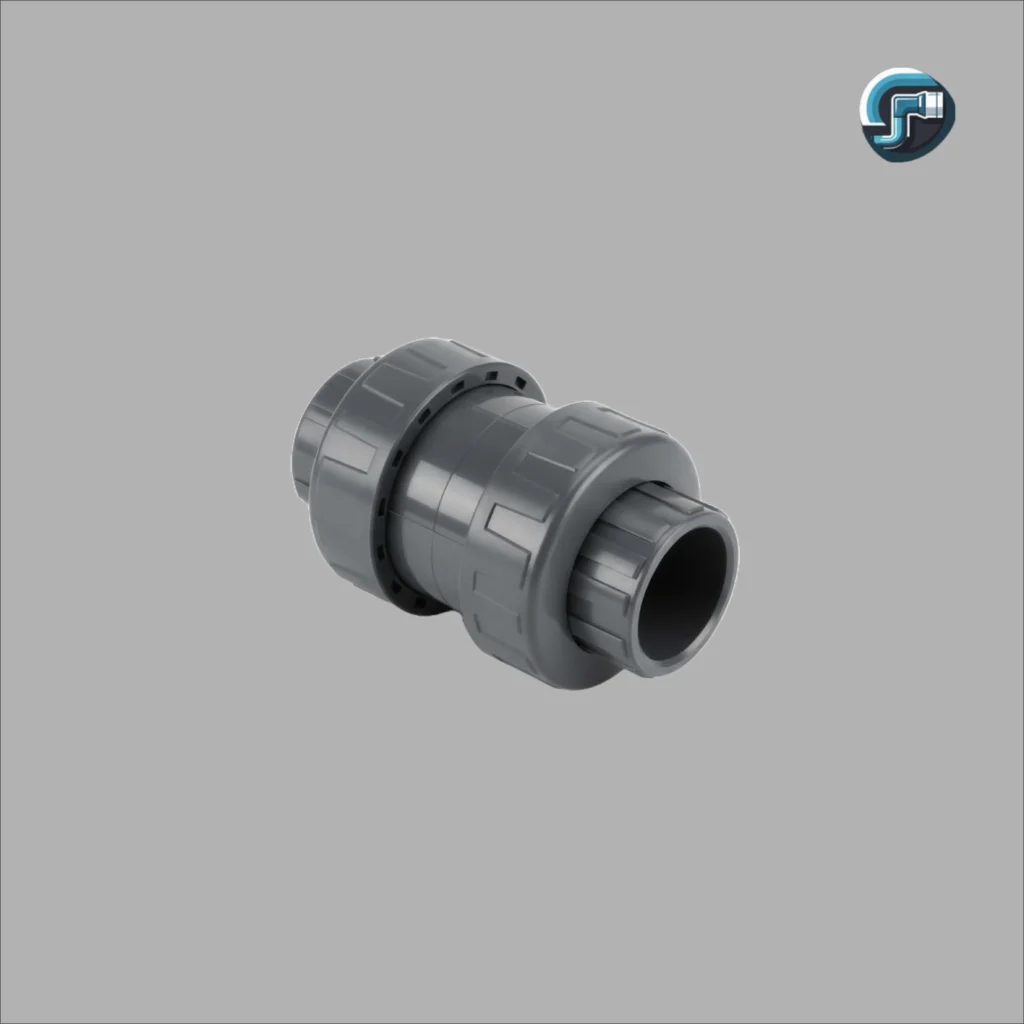
| Nominal Size (Inches) | Nominal Size (mm) | Socket End (mm) | Thread End (BSP/NPT) | Pressure Rating (PSI) | Type Available |
| 1/2″ | 15 mm | 20 mm | 1/2″ | 150 PSI | Swing / Spring |
| 3/4″ | 20 mm | 25 mm | 3/4″ | 150 PSI | Swing / Spring |
| 1″ | 25 mm | 32 mm | 1″ | 150 PSI | Swing / Spring |
| 1 1/4″ | 32 mm | 40 mm | 1 1/4″ | 150 PSI | Swing / Spring |
| 1 1/2″ | 40 mm | 50 mm | 1 1/2″ | 150 PSI | Swing / Spring |
| 2″ | 50 mm | 63 mm | 2″ | 150 PSI | Swing / Spring |
| 2 1/2″ | 65 mm | 75 mm | 2 1/2″ | 150 PSI | Swing (limited) |
| 3″ | 80 mm | 90 mm | 3″ | 150 PSI | Swing / Flap |
| 4″ | 100 mm | 110 mm | 4″ | 150 PSI | Swing / Flap |
| 5″ | 125 mm | 140 mm | 5″ | 150 PSI | Swing / Flap |
| 6″ | 150 mm | 160 mm | 6″ | 150 PSI | Swing / Flap |
PVC Foot Valve
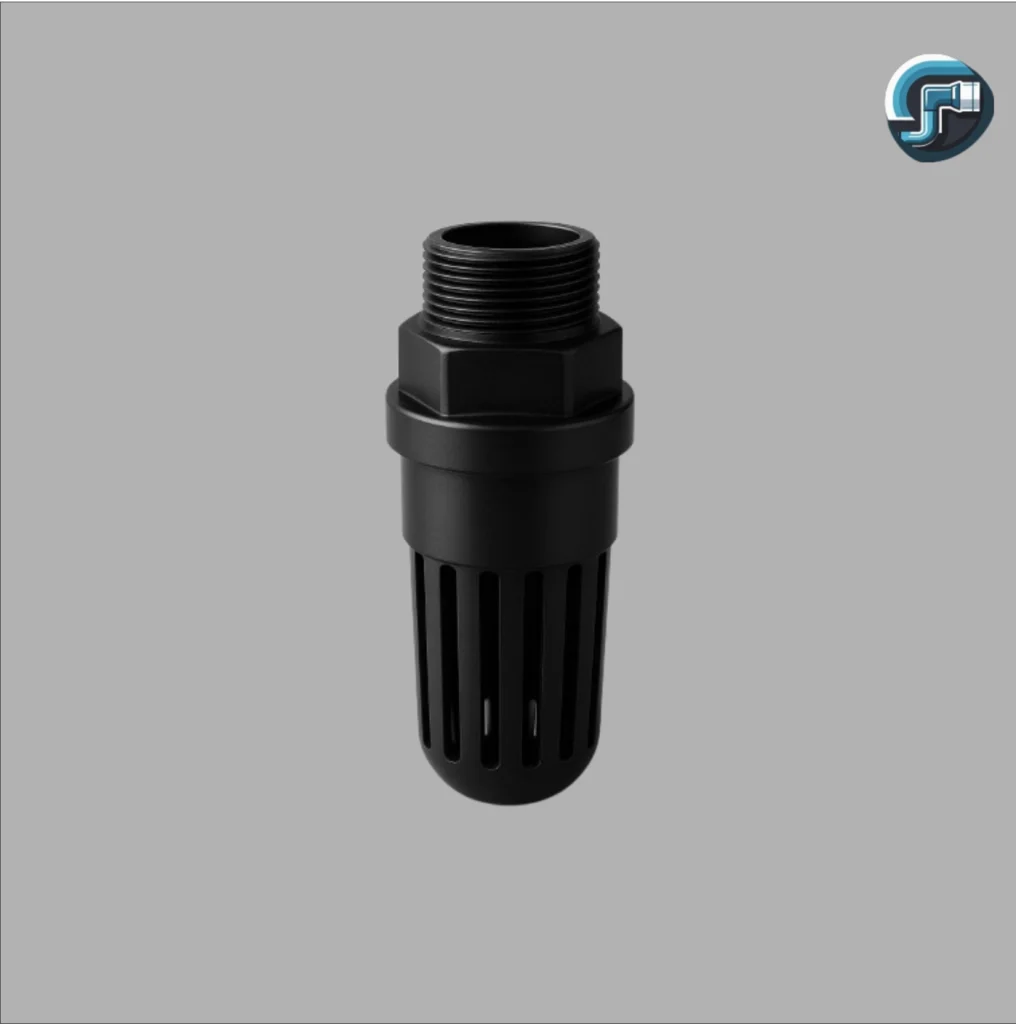
A PVC Foot Valve, much like any other check valve, can permit liquid to only flow in one direction while preventing backflow, which guarantees proper operation of any pumps in use. A foot valve, positioned at the bottom of the suction line of a pump, prevents the loss of pump priming which occurs during the suction pump operation period. A foot valve in pumps is constructed of superior quality polyvinyl chloride which is lightweight, rigid, does not corrode, rust, or react with a number of chemicals, and so can be used in homes and in industrial operation.
What makes a PVC foot valve different from others is the presence of a screen or strainer at the inlet which is, in a sense, additional. This screen serves to block the inflow of unwanted matter such as dirt, sand, leaves and other materials which can cause damage to the sucker line. This in turn, protects the pumps and pipeline from getting clogged. A valve is designed to open during the suction phase of a pump and is held open by the pressure of the fluid from the pump. When the pump stops, the backflow valve automatically closes.
PVC foot valves are preferred in irrigation, wells and boreholes, ponds and pools, and even in water treatment, as well as in agriculture and light industry pumping. They are highly preferred over foot valves made in metal for chemical and corrosive environments, owing to their low weight, easy installation and cost-effectiveness.
On the flip side, PVC is best for low to medium-pressure applications as foot valves made of PVC, like other foot valves, are unsuitable for high temperature systems.
In conclusion a PVC Foot Valve is a vital part of pumping and irrigation systems, having the capacity to intake water efficiently and protect the pump, working for long periods without failure. The combination of a protective strainer and one-way valve make the foot valve highly reliable as well as low cost and low effort. It serves multiple purposes for fluid handling.
| Nominal Size (Inches) | Nominal Size (mm) | Socket End (mm) | Thread End (BSP/NPT) | Pressure Rating (PSI) | Notes |
| 1/2″ | 15 mm | 20 mm | 1/2″ | 150 PSI | With Strainer |
| 3/4″ | 20 mm | 25 mm | 3/4″ | 150 PSI | With Strainer |
| 1″ | 25 mm | 32 mm | 1″ | 150 PSI | With Strainer |
| 1 1/4″ | 32 mm | 40 mm | 1 1/4″ | 150 PSI | With Strainer |
| 1 1/2″ | 40 mm | 50 mm | 1 1/2″ | 150 PSI | With Strainer |
| 2″ | 50 mm | 63 mm | 2″ | 150 PSI | With Strainer |
| 2 1/2″ | 65 mm | 75 mm | 2 1/2″ | 150 PSI | Larger sizes rare |
| 3″ | 80 mm | 90 mm | 3″ | 150 PSI | Common in pumps |
| 4″ | 100 mm | 110 mm | 4″ | 150 PSI | Common in pumps |
| 5″ | 125 mm | 140 mm | 5″ | 150 PSI | Industrial use |
| 6″ | 150 mm | 160 mm | 6″ | 150 PSI | Industrial use |
PVC Globe Valve
A PVC globe valve serves as a flow control equipment that regulates, starts, or stops the movement of a fluid within a piping system. As opposed to ball or gate valves which are designed for quick shut off procedures, globe valves are most useful for flow control. For the globe valves, the flow control system works by moving a disc (or plug) against the stationary ring, which sits in the body of the valve. These valves are constructed from polyvinyl chloride which makes them light, corrosion resistant, and cheap in cost. It is for these reasons these valves are the first choice in applications which require long term durability and resistance to chemicals.
Due to the construction of a PVC globe valve, the valve causes the fluid to change directions as it passes through which results in a greater valve regulation, however, this also causes greater pressure loss than the other valve types. Even with this loss, the globe valves are still useful for applications where precise flow control is necessary.
PVC globe valves are used in water supply systems, in chemical processing, in irrigation, in aquariums, in laboratories, and in wastewater treatment facilities. They are used in industries that need valves that won’t rust, scale, or corrode due to the aggressive nature of various chemicals. They are also easy to install and service and can be operated easily with a simple handwheel or actuator.
They are, however, and tend to be used more often for low to medium-pressure systems, and can never be used on systems meant for high temperatures as PVC, will always soften Nylon.
To conclude, a PVC globe valve very well provides an ideal blend of fine flow control, the globe valve’s skillful use will result in a high durability and low valve system cost. Residential, commercial, or industrial use of the globe valve will always provide a system that regulates fluids with high flow accuracy and with a noncorrosive nature.
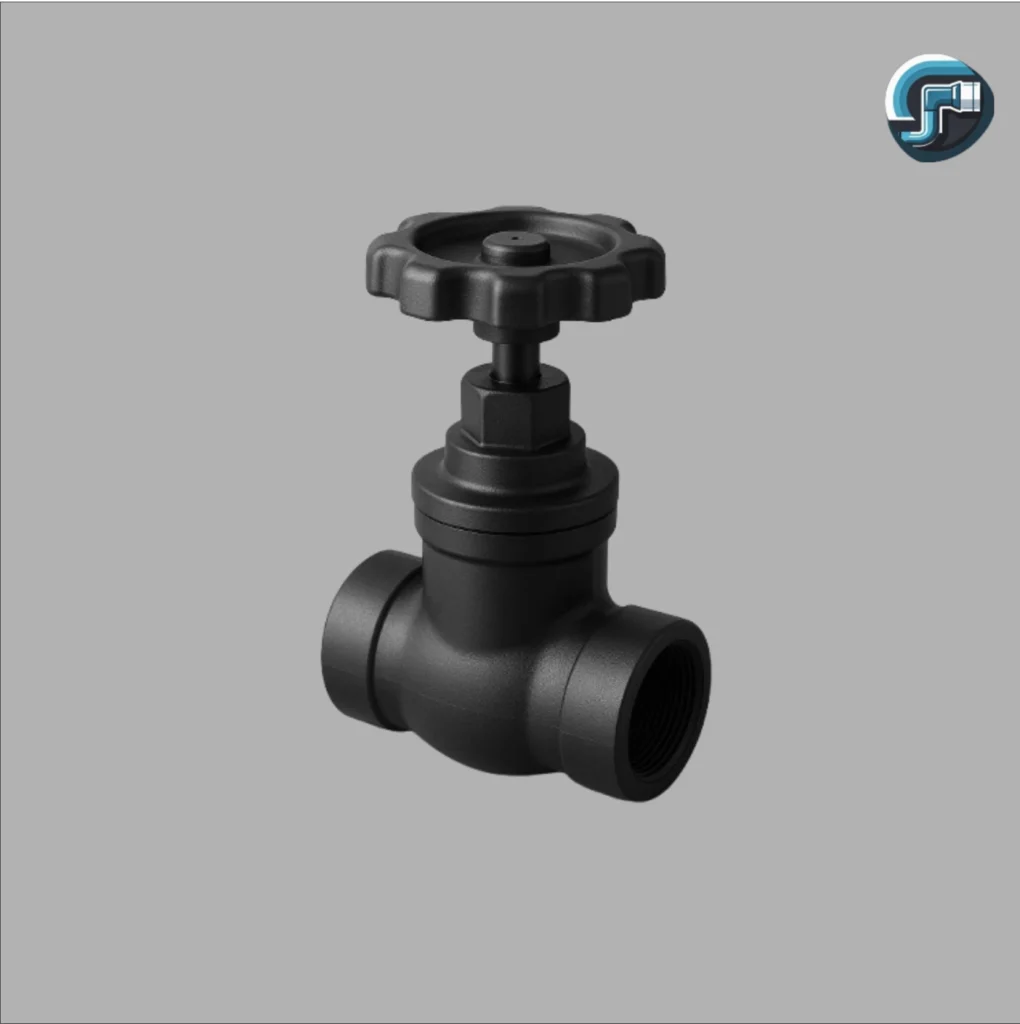
| Nominal Size (Inches) | Nominal Size (mm) | Socket End (mm) | Thread End (BSP/NPT) | Pressure Rating (PSI) |
| 1/2″ | 15 mm | 20 mm | 1/2″ | 150 PSI |
| 3/4″ | 20 mm | 25 mm | 3/4″ | 150 PSI |
| 1″ | 25 mm | 32 mm | 1″ | 150 PSI |
| 1 1/4″ | 32 mm | 40 mm | 1 1/4″ | 150 PSI |
| 1 1/2″ | 40 mm | 50 mm | 1 1/2″ | 150 PSI |
| 2″ | 50 mm | 63 mm | 2″ | 150 PSI |
| 2 1/2″ | 65 mm | 75 mm | 2 1/2″ | 150 PSI |
| 3″ | 80 mm | 90 mm | 3″ | 150 PSI |
| 4″ | 100 mm | 110 mm | 4″ | 150 PSI |
PVC Butterfly Valves
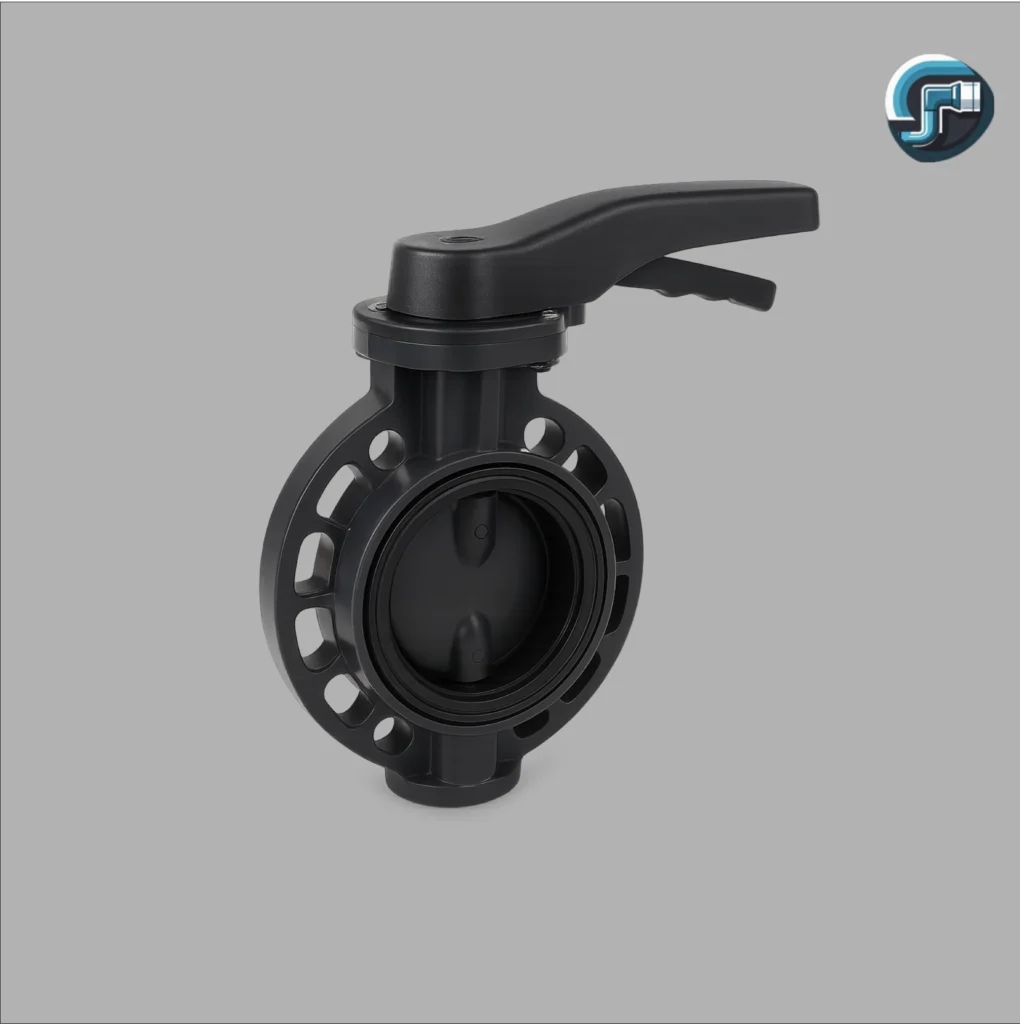
It’s one of the major factors for a successful control of fluid flow through any piping systems that the right valve needs to be selected. PVC butterfly valves, in this sense, are truly multi-faceted, providing reliable performance for many industrial and commercial applications. This valve gives a 90° rotation to achieve either on/off functions in isolation of throttling, thus allowing precise regulation of fluids.
One of the major attributes of PVC butterfly valves is that they resist corrosion with very significant efficiency. Unlike metallic counterparts, the PVC (polyvinyl chloride) material is not prone to corrosion or degradation due to a variety of chemicals, acids, or alkalis. That’s why they are the best choice among other types of valves to suit the application in aggressive working environments, where toughness is the main requirement.
Lightweight materials make the installation easy and cut down on labor time, thus negating the need for heavy equipment or extensive pipe support.
The conjunction of features makes them even more economical. Apart from the low initial cost, eventually, you will also achieve considerable savings on the maintenance and replacement costs. PVC butterfly valves can be found regularly in water treatment plants, where they control the flow of treated and untreated water. They are also an important part of any chemical processing facility.
| Nominal Size (inches) | Nominal Size (mm) | Pressure Rating (PN) | Typical Flange Standard |
| 2″ | 50 mm | PN 10–16 | ANSI/DIN/JIS |
| 2 ½” | 65 mm | PN 10–16 | ANSI/DIN/JIS |
| 3″ | 80 mm | PN 10–16 | ANSI/DIN/JIS |
| 4″ | 100 mm | PN 10–16 | ANSI/DIN/JIS |
| 5″ | 125 mm | PN 10–16 | ANSI/DIN/JIS |
| 6″ | 150 mm | PN 10–16 | ANSI/DIN/JIS |
| 8″ | 200 mm | PN 10–16 | ANSI/DIN/JIS |
| 10″ | 250 mm | PN 10–16 | ANSI/DIN/JIS |
| 12″ | 300 mm | PN 10–16 | ANSI/DIN/JIS |
| 14″ | 350 mm | PN 10–16 | ANSI/DIN/JIS |
| 16″ | 400 mm | PN 10–16 | ANSI/DIN/JIS |
| 18″ | 450 mm | PN 10–16 | ANSI/DIN/JIS |
| 20″ | 500 mm | PN 10–16 | ANSI/DIN/JIS |
| 24″ | 600 mm | PN 10–16 | ANSI/DIN/JIS |
3-Way PVC Valve
A 3-way PVC valve is a vital device in the management of fluids through various systems. A standard 2-port valve only stops or tends to allow flow, but a 3-way valve has three ports: one inlet and two outlets, or two inlets and an outlet. This means that it can perform functions such as diverting flow from one path into another or blending two different input sources, wise fluid; thus, these valves are quite versatile. Therefore, they exist to provide accuracy in flow control.
There are endless applications of a 3-way PVC valve. You have them at home or in the commercial pools and spas, as well as in irrigation systems that channel water into different areas or features. Industrially, they constitute reliable accessories in various activities involving chemical processing and even water treatment.
The main advantage of employing a PVC model is its strength, and the other merits of the PVC model come from it being very inexpensive. PVC is not subject to corrosion, does not corrode with chemicals, and is weather-resistant, resulting in long life and low maintenance. The smooth interior surface reduces pressure loss and buildup. The 3-way PVC valve can serve as an example of a robust, flexible solution for anyone requiring the diversion, mixing, or switching of fluid paths.
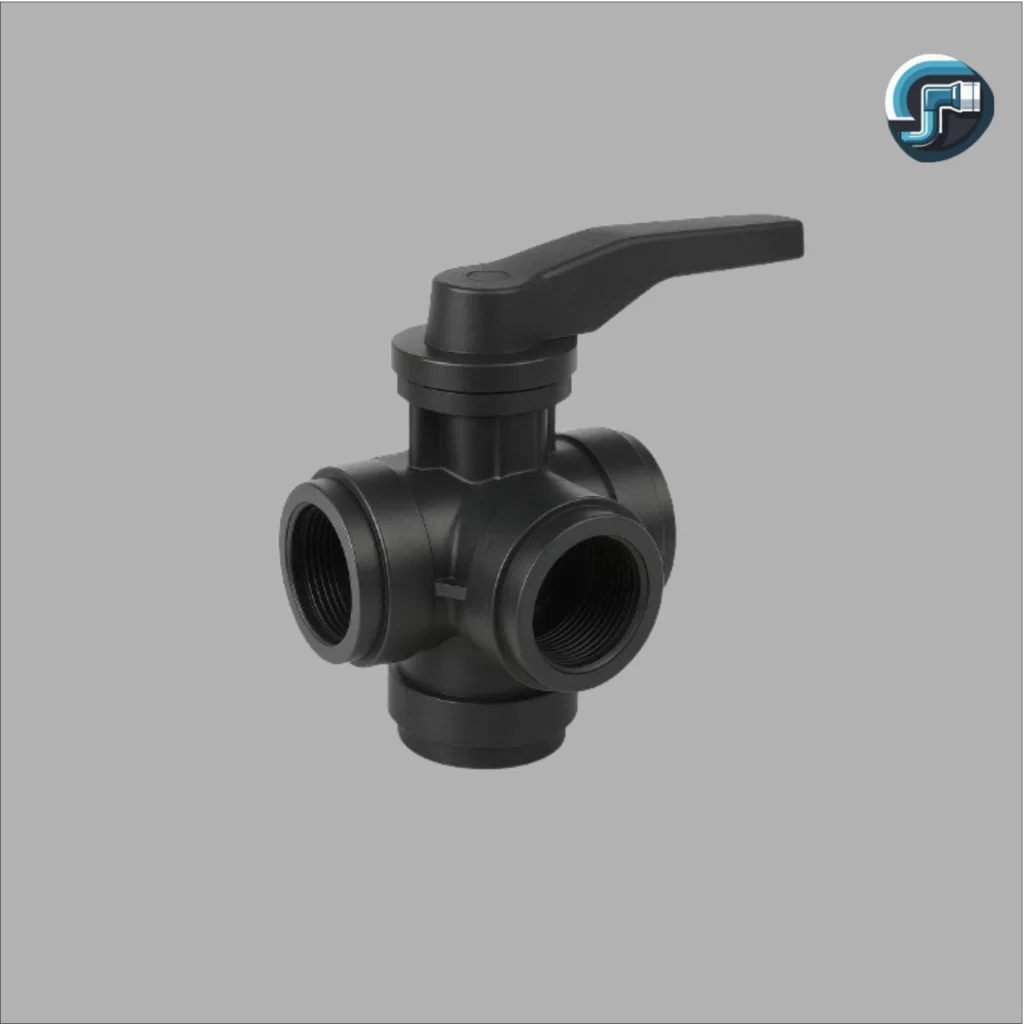
| Nominal Size (inches) | DN (mm) | Port Type | End Connection Options | Approx. Pressure Rating (PSI) |
| 1/2″ | 15 | L-Port / T-Port | Socket, Threaded | 150–235 PSI |
| 3/4″ | 20 | L-Port / T-Port | Socket, Threaded | 150–235 PSI |
| 1″ | 25 | L-Port / T-Port | Socket, Threaded | 150–235 PSI |
| 1 1/4″ | 32 | L-Port / T-Port | Socket, Threaded | 150–235 PSI |
| 1 1/2″ | 40 | L-Port / T-Port | Socket, Threaded | 150–235 PSI |
| 2″ | 50 | L-Port / T-Port | Socket, Threaded, Flanged | 150–235 PSI |
| 2 1/2″ | 65 | L-Port / T-Port | Flanged | 150–235 PSI |
| 3″ | 80 | L-Port / T-Port | Flanged | 150–235 PSI |
| 4″ | 100 | L-Port / T-Port | Flanged | 150–235 PSI |
PVC Diaphragm Valve
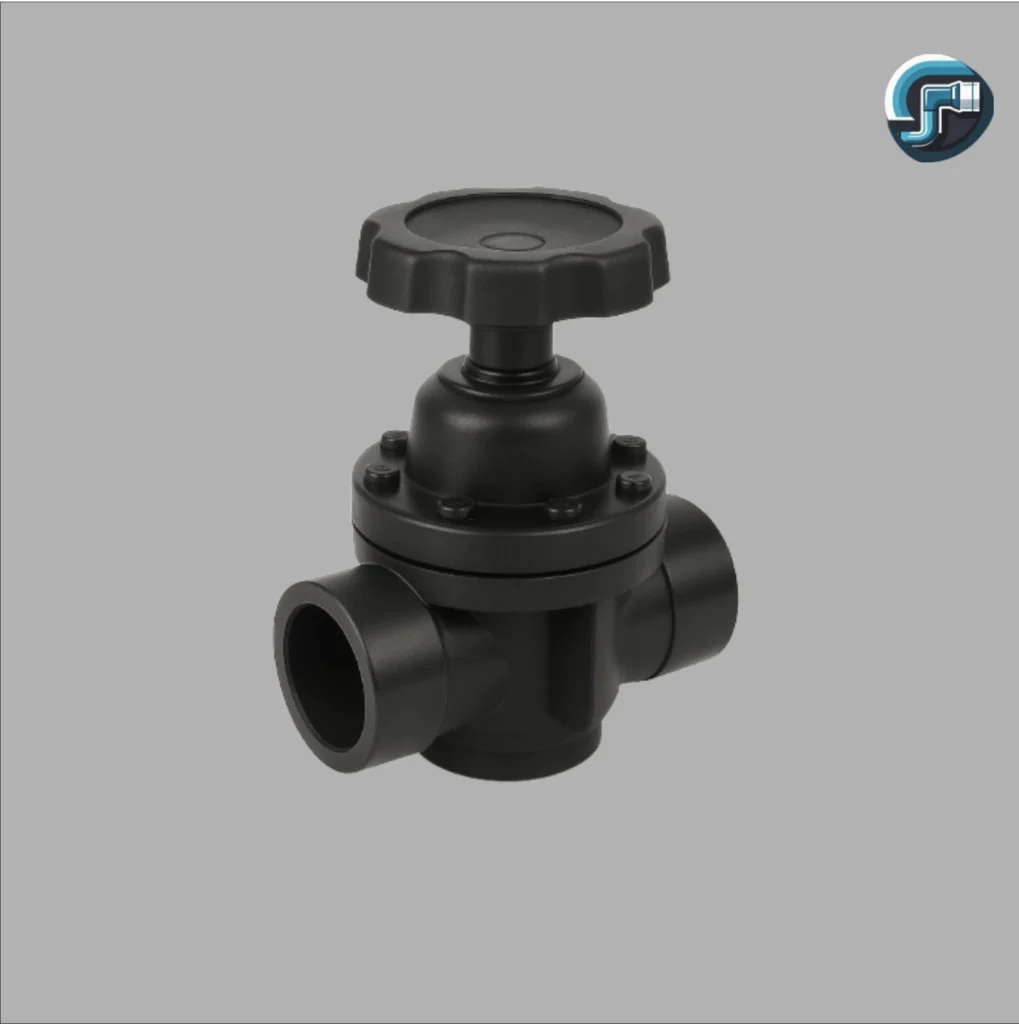
A PVC diaphragm valve is a unique type of valve capable of controlling flow using a flexible diaphragm, which can start and stop the flow of liquids. Though diaphragm valves can perform the same functions as a gate or ball valve, unlike a ball valve or a gate valve, which uses rigid parts, a diaphragm valve can stop the flow of liquid on both sides of the valve, and offers both throttling as well as a leak-proof seal, and can also provide on/off control. These valves can handle a wide variety of fluids and aggressive chemicals, along with slurries and water-based solutions, because PVC is resistant to corrosion, lightweight, and very strong.
The diaphragm valve functions with a simple principle. It can operate with optimum efficiency. Compressor control is performed by using a handwheel or an actuator. When the compressor is moved downwards, it will push the diaphragm against the valve, hence stopping the flow. Fluid can freely be allowed to flow when the valve is open. With this construction, it assists in the minimization of turbulence, which offers fluid in motion excellent shut-off mechanics even in the presence of thick and contaminated fluids.
These PVC diaphragm valves have become famous in the piping systems of industrial use, as well as in laboratories, aquaculture, food and beverage systems, and water treatment plants, along with Chemical Processing. Unlike PVC, the construction material of the diaphragm valves will not rust or become scaled over time. Industrial use will be gained with minimal maintenance and a long service span. These diaphragm valves are best suited to periodic use, along with their durability.
However, diaphragm valves are generally limited to low to medium pressure systems and may not be suitable for very high-temperature applications, since PVC softens under heat.
| Nominal Size (inches) | DN (mm) | End Connection Options | Typical Pressure Rating (PSI) |
| 1/2″ | 15 | Socket, Threaded | 150–235 PSI |
| 3/4″ | 20 | Socket, Threaded | 150–235 PSI |
| 1″ | 25 | Socket, Threaded | 150–235 PSI |
| 1 1/4″ | 32 | Socket, Threaded | 150–235 PSI |
| 1 1/2″ | 40 | Socket, Threaded | 150–235 PSI |
| 2″ | 50 | Socket, Threaded, Flanged | 150–235 PSI |
| 2 1/2″ | 65 | Flanged | 150–235 PSI |
| 3″ | 80 | Flanged | 150–235 PSI |
| 4″ | 100 | Flanged | 150–235 PSI |
Frequently Asked Questions (FAQ’s)
Conclusion
The PVC valves are essentially strong, cheap, and flexible, thus making them one of the most reliable options when it comes to household use or very complex industrial systems. They will indeed resist corrosion and chemical attack, ensuring years of operation with little or no maintenance. The secret behind having these benefits lies in selecting the right kind and size of valve according to the requirements. Therefore, some time needs to be spent on understanding the system to get the best safety and efficiency.


